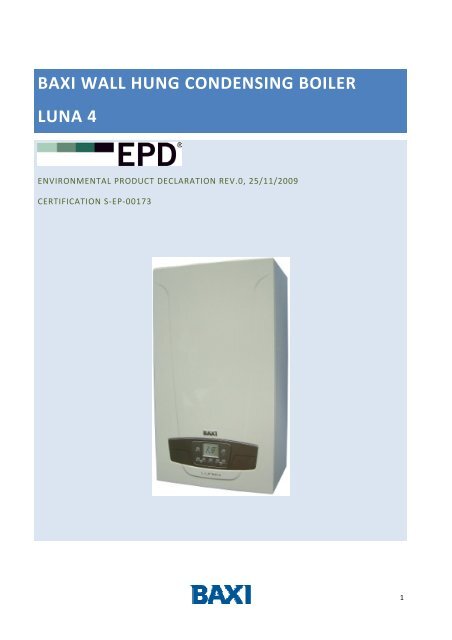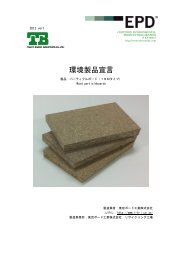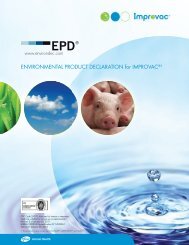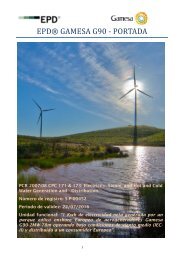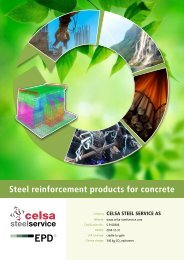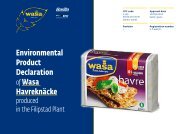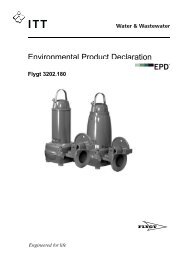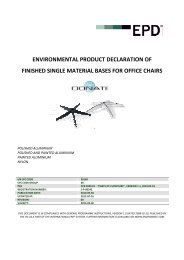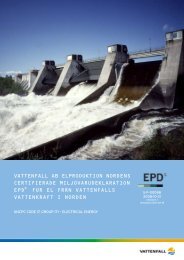BAXI WALL HUNG CONDENSING BOILER LUNA 4
BAXI WALL HUNG CONDENSING BOILER LUNA 4
BAXI WALL HUNG CONDENSING BOILER LUNA 4
- No tags were found...
Create successful ePaper yourself
Turn your PDF publications into a flip-book with our unique Google optimized e-Paper software.
<strong>BAXI</strong> <strong>WALL</strong> <strong>HUNG</strong> <strong>CONDENSING</strong> <strong>BOILER</strong><strong>LUNA</strong> 4ENVIRONMENTAL PRODUCT DECLARATION REV.0, 25/11/2009CERTIFICATION S‐EP‐001731
TECHNICAL DATABoiler model: <strong>LUNA</strong>4 STANDARD COMBI 28Max DHW Heat Input kW 28,9Max Heat Input kW 24,7Min Heat Input kW 4,1Max DHW Heat OutputkW 28kcal/h 24080Max Heat Output 75/60°CkW 24kcal/h 20640Max Heat Output 50/30°CkW 25,9kcal/h 22304Min Heat Output 75/60°CkW 4,0kcal/h 3440Min Heat Output 50/30°CkW 4,3kcal/h 3702Max Operating Central Heating Primary Circuit bar 3Min Operating Central Heating Primary Circuit bar 0,5Expansion Vessel – Water content l 8DHW Circuit Pressures – max Operating bar 8,0DHW Circuit Pressures – min Operating bar 0,15Min Working DHW Flow Rate l/min 2,0DHW Flow Rate ∆T = 25 °C Rise l/min 16,1DHW Flow Rate ∆T = 35 °C Rise l/min 11,5Specific Rate (*) “D” l/min 12,9DHW Flow Temperature (Adjustable) °C 35÷60Max. mass flow of fumes kg/s 0,014Min. mass flow of fumes kg/s 0,002Max. fumes temperature °C 78NOx class ‐ 5Natural gas supply pressure 2H mbar 20Propane gas supply pressure 3P mbar 37Power supply voltage V 230Power supply frequency Hz 50Power Consumption W 150Net weight kg 37Protection against humidity and water penetration (**) ‐( ** ) according to EN 60529The above data, are commonly used to describe the technical performance of the machine.3
LIST OF MATERIALSLuna 4: Aluminium Heat ExchangerWith BRASS hydraulic groupWith COMPOSITE hydraulic groupTotal weight (kg) 48,2 Total weight (kg) 46,9Material % Material %Generic steel 45,5% Generic steel 47,2%Cast Aluminium 25,7% Cast Aluminium 26,4%Brass 8,8% Brass 4,5%Stainless Steel 3,4% Stainless Steel 3,5%Copper 3,3% Copper 3,3%PP 2,1% PP 2,2%Other materials 11,2% Other materials 12,9%Luna 4: Stainless Steel Heat ExchangerWith BRASS hydraulic groupWith COMPOSITE hydraulic groupTotal weight (kg) 44,0 Total weight (kg) 42,8Material % Material %Generic steel 47,2% Generic steel 48,9%Stainless Steel 18,4% Stainless Steel 19,0%Brass 9,4% Cast Aluminium 5,3%Cast Aluminium 5,1% PPO 4,7%PPO 2,9% Brass 4,6%Copper 2,6% Copper 2,7%Other materials 14,4% Other materials 14,8%4
ENVIRONMENTAL PERFORMANCE DECLARATIONMETHODOLOGYThe environmental performance of the considered system has been quantified by Life Cycle Assessment(LCA) approach in accordance with ISO 14040 series. Data used for the study refers to year 2007, dataconcerning the boiler are representative of the product. Specific and generic data fulfill General ProgramInstruction criteria for EPD.The use phase has been modeled by averaging space heating and hot domestic water production with nooverlapping.Space heating takes into consideration a residential house with the following characteristics:FeaturesNet Area 160 m 2Heat Load (Net energy requirement index)Heating seasonWorking definitionRegimeInternal temperature (day‐time) 25 °CInternal temperature (night‐time) 21 °CMarket100 kWh/m 2 ∙yearFrom September to May (273 days)24 hours per dayNot continuous (soft in night‐time)EU (average of 27 Countries)Hot domestic water data are from test according EN 13203-2 Cycle 4 (the heaviest cycle fulfilled by theboiler).FUNCTIONAL UNITThe functional unit (F.U.) for this analysis is defined as 1.000 kWh of net thermal energy available balancedamong Domestic Hot Water and Heating Generation during a standard production cycle.5
SYSTEM BOUNDARIESFig. 2 – System boundaries. All main operations from the extraction of natural resources to the usephase (when the product is able to deliver the functional unit) are included.The considered System is split into two phases according to the following hypothesis:UPSTREAM OPERATIONS:−−−−−raw materials extraction, preparation and treatment for components manufacturing;transports involved by the system from raw materials extraction to the assembling plant;transports to <strong>BAXI</strong> plant and assembling of parts and components at <strong>BAXI</strong> plant;production and distribution of the energy carriers used in the processes;the energy mix refers to the different countries where the components are manufactured.6
CORE PROCESS (USE PHASE)−−−materials use, energy consumption and emissions to the environment of the boiler;the energy mix refers to European average;A Standard Production Cycle for Domestic Hot Water and Heating Generation, has been defined.Standards used are below:o UNI EN 13203 part 2: Domestic Hot water (Cycle 4)oooUNI/TS 11300 (heating)UNI EN 483 (CO, NOx emission)UNI EN 437 (HHV, LHV)−−Maintenance and ancillary materials (e.g. stack, distribution systems, radiant heated floor, …) areomittedin accordance with uncertainty on end of life scenarios which depend on markets in which the boilerwill operate, no end-of-life scenario is here defined.7
ENVIRONMENTAL RESULTSRESOURCE CONSUMPTIONNON RENEWABLE RESOURCES Stainless steel Stainless steel Aluminium Aluminiumdata for 1000 kWh of net thermal energybrass composite brass compositeUP CORE UP CORE UP CORE UP COREIron (Fe) 165 ‐ 166 ‐ 154 ‐ 155 ‐Bauxite 45 ‐ 45 ‐ 210 ‐ 210 ‐Copper (Cu) ‐ ‐ ‐ ‐ 22 ‐ 15 ‐Material resources [g]Sodium Chloride (NaCl) 29 ‐ 29 ‐ 15 ‐ 16 ‐Limestone (CaCO3) 27 21 27 21 ‐ 21 ‐ 21Clay ‐ 18 ‐ 18 ‐ 18 ‐ 18Others 66 10 53 10 54 10 46 10Total of material resources [g] 332 49 320 49 455 49 442 49Coal 4 109 4 109 11 109 11 109Crude Oil 4 42 4 42 6 42 6 42Energy resources [MJ]Natural gas 5 4.420 5 4.420 5 4.420 5 4.420Nuclear 1 111 1 111 1 111 1 111Other ‐ 1 ‐ 1 ‐ 1 ‐ 1Total of energy resources [MJ] 14 4.683 14 4.683 23 4.683 23 4.6838
RENEWABLE RESOURCES Stainless steel Stainless steel Aluminium Aluminiumdata for 1000 kWh of net thermal energyBrass Composite Brass CompositeUP CORE UP CORE UP CORE UP COREMaterial resources [g]Iron/Steel scraps 26 ‐ 26 ‐ 27 ‐ 27 ‐Others 7 ‐ 7 ‐ 7 ‐ 7 ‐Total of material resources [g] 33 ‐ 33 ‐ 34 ‐ 34 ‐Hydro 1 20 1 20 1 20 1 20Energy resources [MJ] Wood and biomass 0 2 0 2 0 2 0 2Other 0 3 0 3 0 3 0 3Total of energy resources [MJ] 1 25 1 25 1 25 1 25WATER CONSUMPTION Stainless steel Stainless steel Aluminium Aluminiumdata for 1000 kWh of net thermal Brass Composite Brass CompositeenergyUP CORE UP CORE UP CORE UP CORELitre 10 5 10 5 11 5 11 5WASTE GENERATION Stainless steel Stainless steel Aluminium AluminiumBrass Composite Brass Compositedata for 1000 kWh of net thermal energyUP CORE UP CORE UP CORE UP COREHazardous 0 0 0 0 0 0 0 0[kg]Non hazardous 3 1 2 1 3 1 3 19
POLLUTANT EMISSIONS EXPRESSED IN TERMS OF POTENTIAL ENVIRONMENTALIMPACTENVIRONMENTAL IMPACTSStainlesssteelStainlesssteelAluminiumAluminiumdata for 1000 kWh of net thermal energyGlobal Warming PotentialGWP 100 [kg CO2]Acidification PotentialAP [g SO2 eq]Eutroph. PotentialEP [g PO4]Ozone Depletion PotentialODP [g CFC11]Photochemical Ozone Creation PotentialPOCP [g C2H4]Brass Composite Brass CompositeUP CORE UP CORE UP CORE UP CORE1 328 1 328 2 328 2 32821 176 21 176 16 176 16 1760 15 0 15 1 16 1 160 0 0 0 0 0 0 01 42 1 42 1 42 1 42ADDITIONAL INFORMATION AND REFERENCESCONTRIBUTIONS AND OTHER INFORMATION−Contribution of different phases to total results10
−Contribution to use phase:−Materials that may potentially be recycledStainless steel Stainless steel Aluminium AluminiumBrass Composite Brass Composite77% 77% 77% 78%CONTRIBUTION OF OTHER GENERIC DATAOther generic data contributions fulfill EPD requirements being less than 1%.ENVIRONMENTAL PHILOSOPHY OF THE COMPANY<strong>BAXI</strong> S.p.A has developed CSQ-certified quality management (ISO 9001), environmental (ISO 14001) andhealth and safety (OHSAS 18001) systems.<strong>BAXI</strong> recognises as its strategic objectives:−−−−customer needs fulfillment, both on the product and service point of viewthe environment safeguard , being a front-runner in renewable technologythe health and safety of its employeesthe safety, reliability and quality of its products11
CONTACTSBaxi S.p.A.Via Trozzetti, 20 - 36061 Bassano del Grappa (VI) – ItalyTel: +39 0424 517111Fax: +39 0424 38089giorgio.lunardi@baxi.itgiordano.bello@baxi.itclaudio.contato@baxi.itwww.baxi.itREFERENCES− Life cycle assessment of <strong>LUNA</strong> 4 Final report - 06 Oct. 2009.−Luna 4 operating manual (available on demand)− UNI/TS 11300− UNI EN 13203− UNI EN 483− UNI EN 437INFORMATION ABOUT THE CERTIFYING BODY AND ABOUT THE PCRPCR: unavailableIndependent verification of the declaration and data, according to ISO 14025:□ Internalx externalThird party verifier: ICMQ - Sincert accreditation number 002HValid until: 24/11/2010Please note that EPDs obtained with different programs may not be comparable12
GLOSSARYAcidification Potential(AP): phenomenon by which atmospheric rainfall has a pH which is lower thanaverage. This may cause damage in forests and cultivated fields, as well as in water ecosystems and objectsin general. This phenomenon is due to the emissions of SO2, of NOx, and NH3, which are included in theAcidification Potential (AP) index expressed in masses of H+ produced.Ozone Depletion Potential (ODP): degradation and depletion of the ozone layer in the stratosphere, whichhas the property of blocking the ultraviolet components of sunlight thanks to its particularly reactivecompounds, originated by chlorofluorocarbons (CFC) or by chlorofluoromethanes (CFM). The substanceused as a point of reference for assessing the ODP (Ozone Depletion Potential) is trichlorofluoromethane, orCFC-11.Global Warming Potential (GWP): phenomenon by which the infrared rays emitted by the earth’s surfaceare absorbed by the molecules in the atmosphere as a result of solar warming and then re-emitted in theform of heat, thus giving rise to a process of global warming of the atmosphere. The indicator used for thispurpose is GWP (Global Warming Potential). This mainly includes the emissions of carbon dioxide, the maingreenhouse gas, as well as other gases with a lower degree of absorption of infrared rays, such as methane(CH4), nitrogen protoxide (N2O), chlorofluorocarbons (CFC), which are expressed according to the degree ofabsorption of CO2 (g CO2 ).Eutrophication Potential (EP): enrichment of the watercourses by the addition of nutrients. This causesimbalance in water ecosystems due to the overdevelopment encouraged by the excessive presence ofnourishing substances. In particular, the Eutrophication Potential (EP) includes phosphorous and nitrogensalts and it is expressed in grams of oxygen (g O2).Photochemical Ozone Creation Potential (POCP): production of compounds which by the action of lightare capable of encouraging an oxidising reaction leading to the production of ozone in the troposphere. Theindicator POCP (Photochemical Ozone Creation Potential) includes especially VOC (volatile organiccompounds) and is expressed in grams of ethylene (g C2H4).13


